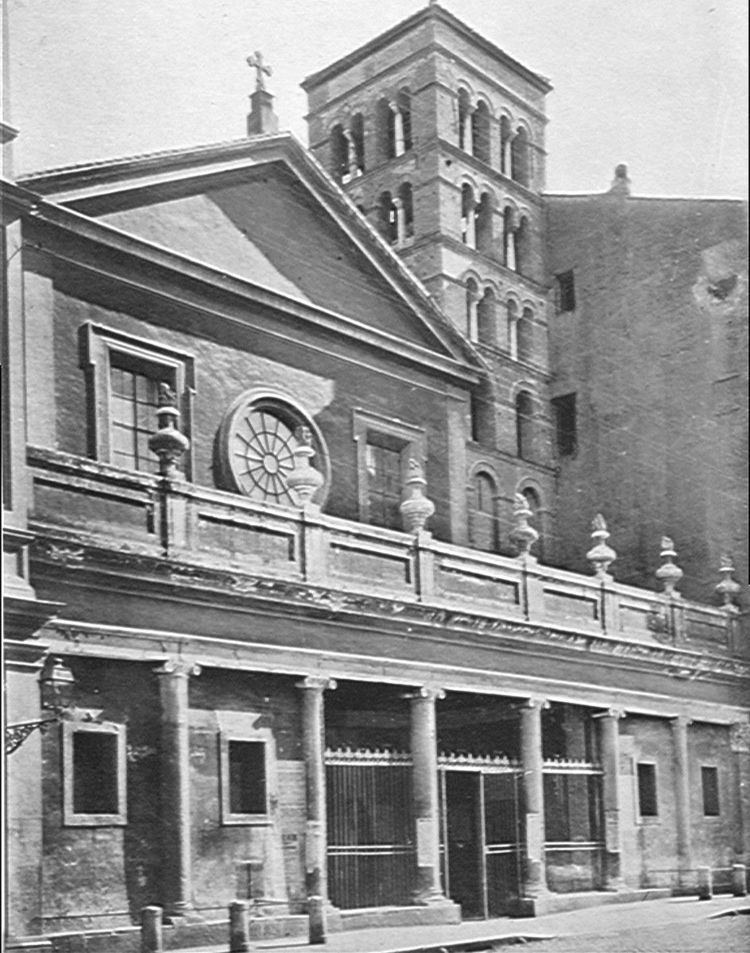Website Official website Length 65 metres (213 ft) | Affiliation Roman Catholic Groundbreaking AD 4th century Phone +39 06 687 1494 Function Church | |
 | ||
Similar Basilica of Saints John and, Santi Apostoli - Rome, Sant'Andrea delle Fratte, Largo di Torre Argentina, San Crisogono - Rome | ||
San lorenzo in lucina
Bold text The Minor Basilica of St. Lawrence in Lucina (Italian: Basilica Minore di San Lorenzo in Lucina or simply Italian: San Lorenzo in Lucina; Latin: S. Laurentii in Lucina) is a Roman Catholic parish, titular church, and minor basilica in central Rome, Italy. The basilica is located in Piazza di San Lorenzo in Lucina in the Rione Colonna, circa two blocks behind the Palazzo Montecitorio, proximate to the Via del Corso.
Contents
- San lorenzo in lucina
- San lorenzo in lucina una parrocchia nel cuore di roma
- History
- Art and architecture
- Interments
- References
San lorenzo in lucina una parrocchia nel cuore di roma
History
The basilica is dedicated to St. Lawrence of Rome, deacon and martyr. The name "Lucina" derives from that of the Roman matron of the AD 4th century who permitted Christians to erect a church on the site. Putatively, Pope Marcellus I hid on the site during the persecutions of Roman Emperor Maxentius, and Pope Damasus I was elected there in AD 366. Pope Sixtus III consecrated a church on the site in 440 AD. The church was denominated the Titulus Lucinae, and thus is mentioned in the acts of the synod of AD 499 of Pope Symmachus. The church was first reconstructed by Pope Paschal II in the early 12th century.
In 1606, Pope Paul V assigned the basilica to the order of Clerics Regular Minor. Cosimo Fanzago completely renovated the interior in the 17th century, including conversion of the lateral aisles of the basilica into chapels. The ceiling was also frescoed by the Neapolitan Mometto Greuter.
In the 19th century, in a subsequent restoration of the interior that Pope Pius I commissioned the Baroque decorations in the nave were replaced with frescoes that Roberto Bompiani painted.
The current Cardinal Priest of the Titulus S. Laurentii in Lucina, established in AD 684, is Malcolm Ranjith Patabendige Don, Archbishop of Colombo, Sri Lanka, who was appointed on 20 November 2010.
Art and architecture
In the rebuilding of 1650, the aisled basilical plan was destroyed and the lateral naves were replaced by Baroque chapels, which were then leased to noble families to decorate and use as mausolea. This was done by inserting walls behind the piers of the arcades. The arcades themselves have solid, square piers with imposts. The flat ceiling is coffered, gilded, and decorated with rosettes and has a painting of the Apotheosis of St. Lawrence in the central panel. This ceiling was made in 1857 under Pope Pius IX.
Guido Reni's Christ on the Cross (1639-40) is visible above the high altar, framed by six Corinthian columns of black marble. Below the altar is a reliquary in which is preserved the gridiron on which tradition maintains that St. Lawrence was martyred. The marble throne of Pope Paschal II in the apse behind the high altar has an inscription that records the translation to the basilica of its relics of St. Lawrence of Rome. A Madonna and Child with John of Nepomuk and Archangel Michael by Onofrio Avellino hangs in the apse behind the high altar.
Gian Lorenzo Bernini designed the Capella Fonseca, fourth on the right, for the Portuguese Gabriele Fonseca, who was physician to Pope Innocent X (1644-55). The chapel has some fine busts by Bernini and his workshop, including a portrait of Fonseca to the left of the altar. This chapel also has the painting Elisha Pouring Salt into the Bitter Fountain by Giacinto Gimignani of 1664.
The French artist Nicolas Poussin (1594–1665) is buried in the second chapel on the right side and is commemorated with a monument that the French Ambassador François-René de Chateaubriand donated in 1830.
The second chapel on the left has an altarpiece by Carlo Saraceni.
The fifth chapel on the left was designed and decorated by Simon Vouet. His two paintings depict St. Francis of Assisi: one shows him receiving his religious habit and the other depicts his temptations. The altarpiece shows St. Francis Appearing to Giacinta Marescotti on Her Deathbed by Marco Benefial.
Giuseppe Sardi designed the baptistery to the left of the entrance in the 17th century.
In the basilica is also the tomb of the composer Bernardo Pasquini (1637-1710). Three years after the composer's death, his portrait was placed there, sculpted in Carrara marble by Pietro Francesco Papaleo (circa 1642-1718). The portrait was a commission by the composer's nephew Felice Bernardo Ricordati and his pupil Bernardo Gaffi.
Charles Stewart, an officer in the Papal army who died in 1864, is buried in the basilica. He was the son of John Stewart, Prince Charles Edward Stuart's ("Charles III", the "Young Pretender") "maestro di casa". Charles had ennobled John as a baronet in 1784.
